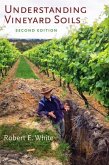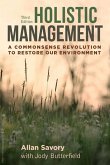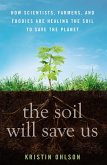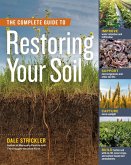Garrison Sposito
The Chemistry of Soils, 3rd edition
Schade – dieser Artikel ist leider ausverkauft. Sobald wir wissen, ob und wann der Artikel wieder verfügbar ist, informieren wir Sie an dieser Stelle.
Garrison Sposito
The Chemistry of Soils, 3rd edition
- Gebundenes Buch
- Merkliste
- Auf die Merkliste
- Bewerten Bewerten
- Teilen
- Produkt teilen
- Produkterinnerung
- Produkterinnerung
A revised edition to the bestselling "The Chemistry of Soils" incorporating new research from the last eight years in the fields of environmental chemistry, ecosystem biogeochemistry, and scientific agriculture.
Andere Kunden interessierten sich auch für
![Phosphorus Phosphorus]() Jim Elser (Bierman Professor of Ecolo Bierman Professor of EcologyPhosphorus42,99 €
Jim Elser (Bierman Professor of Ecolo Bierman Professor of EcologyPhosphorus42,99 €![Successful Farming [microform]: a Ready Reference on All Phases of Agriculture for Farmers of the United States and Canada: Including Soils, Manures . Successful Farming [microform]: a Ready Reference on All Phases of Agriculture for Farmers of the United States and Canada: Including Soils, Manures .]() Successful Farming [microform]: a Ready Reference on All Phases of Agriculture for Farmers of the United States and Canada: Including Soils, Manures .38,99 €
Successful Farming [microform]: a Ready Reference on All Phases of Agriculture for Farmers of the United States and Canada: Including Soils, Manures .38,99 €![Understanding Vineyard Soils Understanding Vineyard Soils]() Robert E. WhiteUnderstanding Vineyard Soils96,99 €
Robert E. WhiteUnderstanding Vineyard Soils96,99 €![Holistic Management, Third Edition Holistic Management, Third Edition]() Allan SavoryHolistic Management, Third Edition49,99 €
Allan SavoryHolistic Management, Third Edition49,99 €![The Soil Will Save Us The Soil Will Save Us]() Kristin OhlsonThe Soil Will Save Us28,99 €
Kristin OhlsonThe Soil Will Save Us28,99 €![The Intelligent Gardener The Intelligent Gardener]() Steve SolomonThe Intelligent Gardener19,99 €
Steve SolomonThe Intelligent Gardener19,99 €![The Complete Guide to Restoring Your Soil The Complete Guide to Restoring Your Soil]() Dale StricklerThe Complete Guide to Restoring Your Soil22,99 €
Dale StricklerThe Complete Guide to Restoring Your Soil22,99 €-
-
A revised edition to the bestselling "The Chemistry of Soils" incorporating new research from the last eight years in the fields of environmental chemistry, ecosystem biogeochemistry, and scientific agriculture.
Produktdetails
- Produktdetails
- Verlag: Oxford University Press Inc
- 3 Revised edition
- Seitenzahl: 272
- Erscheinungstermin: 21. November 2016
- Englisch
- Abmessung: 241mm x 164mm x 25mm
- Gewicht: 526g
- ISBN-13: 9780190630881
- ISBN-10: 0190630884
- Artikelnr.: 47868819
- Herstellerkennzeichnung
- Libri GmbH
- Europaallee 1
- 36244 Bad Hersfeld
- gpsr@libri.de
- Verlag: Oxford University Press Inc
- 3 Revised edition
- Seitenzahl: 272
- Erscheinungstermin: 21. November 2016
- Englisch
- Abmessung: 241mm x 164mm x 25mm
- Gewicht: 526g
- ISBN-13: 9780190630881
- ISBN-10: 0190630884
- Artikelnr.: 47868819
- Herstellerkennzeichnung
- Libri GmbH
- Europaallee 1
- 36244 Bad Hersfeld
- gpsr@libri.de
Gary Sposito was the former Chair in Soil Science and is now Professor Emeritus of Ecosystem Sciences and Environmental Engineering, University of California, Berkeley.
1 The Composition of Soils
1.1 Natural Capital
1.2 Soil Pore Fluids
1.3 Soil Minerals as Nutrient Capital
1.4 How Minerals Weather
1.5 Soil Humus as Nutrient Capital
For Further Reading
Problems
2 Soil Minerals
2.1 How Mineral Structures Form
2.2 Primary Silicates as Nutrient Capital
2.3 Clay Minerals and Cation Retention
2.4 Metal Oxide Minerals and Ion Retention
2.5 Soil Carbonates and Sulfates
For Further Reading
Problems
3 Soil Humus
3.1 Biomolecules in Humus
3.2 Humus Composition
3.3 Stabilizing Soil Humus
3.4 Humus Buffering
3.5 Reactions with Organic Chemicals
For Further Reading
Problems
4 The Soil Solution
4.1 Sampling Soil Solutions
4.2 Soluble Complexes
4.3 Chemical Speciation
4.4 Calculating Chemical Speciation
4.5 Calculating Conditional Stability Constants
For Further Reading
Problems
5 Mineral Weathering
5.1 Mineral Dissolution
5.2 Mineral Weathering Sequences
5.3 Mineral Stability during Weathering
5.4 The GLO Step Rule
5.5 Phosphate Transformations in Calcareous Soils
For Further Reading
Problems
6 Oxidation-Reduction Reactions
6.1 Flooded Soils
6.2 Understanding Transformations in Flooded Soils
6.3 Generalizing the Sequence: The Redox Ladder
6.4 Exploring the Redox Ladder
6.5 pE-pH Diagrams
For Further Reading
Problems
7 Soil Particle Surface Charge
7.1 Structural Charge
7.2 Stern Layer Charge
7.3 Surface Charge
7.4 Points of Zero Charge
7.5 Schindler Diagrams
For Further Reading
Problems
8 Soil Adsorption Phenomena
8.1 Measuring Adsorption
8.2 Modeling Adsorption
8.3 Understanding Metal Cation Adsorption
8.4 Understanding Anion Adsorption
8.5 Surface Redox Processes
For Further Reading
Problems
9 Exchangeable Ions
9.1 Defining Exchange Capacity
9.2 Defining Exchange Isotherms
9.3 Understanding Ion Exchange Selectivity
9.4 Toxic Metals in Soils: Biotic Ligand Model
9.5 Humus Buffering: NICA-Donnan Model
For Further Reading
Problems
10 Soil Colloids
10.1 Defining Soil Colloids
10.2 Understanding Flocculation
10.3 Rapid Flocculation: The Schulze-Hardy Rule
10.4 Rapid Flocculation and Ionicity
10.5 Slow Flocculation
For Further Reading
Problems
11 Soil Acidity
11.1 Proton Cycling and Soil pH
11.2 Acid-Neutralizing Capacity
11.3 The Problem of Aluminum
11.4 Redox Reactions and Soil pH
11.5 Neutralizing Soil Acidity
For Further Reading
Problems
12 Soil Salinity
12.1 Exploring Saline Soil Solutions
12.2 Sodicity and Salinity
12.3 Mineral Weathering in Arid-Zone Soils
12.4 The Problem of Boron
12.5 Irrigation Water Quality
For Further Reading
Problems
1.1 Natural Capital
1.2 Soil Pore Fluids
1.3 Soil Minerals as Nutrient Capital
1.4 How Minerals Weather
1.5 Soil Humus as Nutrient Capital
For Further Reading
Problems
2 Soil Minerals
2.1 How Mineral Structures Form
2.2 Primary Silicates as Nutrient Capital
2.3 Clay Minerals and Cation Retention
2.4 Metal Oxide Minerals and Ion Retention
2.5 Soil Carbonates and Sulfates
For Further Reading
Problems
3 Soil Humus
3.1 Biomolecules in Humus
3.2 Humus Composition
3.3 Stabilizing Soil Humus
3.4 Humus Buffering
3.5 Reactions with Organic Chemicals
For Further Reading
Problems
4 The Soil Solution
4.1 Sampling Soil Solutions
4.2 Soluble Complexes
4.3 Chemical Speciation
4.4 Calculating Chemical Speciation
4.5 Calculating Conditional Stability Constants
For Further Reading
Problems
5 Mineral Weathering
5.1 Mineral Dissolution
5.2 Mineral Weathering Sequences
5.3 Mineral Stability during Weathering
5.4 The GLO Step Rule
5.5 Phosphate Transformations in Calcareous Soils
For Further Reading
Problems
6 Oxidation-Reduction Reactions
6.1 Flooded Soils
6.2 Understanding Transformations in Flooded Soils
6.3 Generalizing the Sequence: The Redox Ladder
6.4 Exploring the Redox Ladder
6.5 pE-pH Diagrams
For Further Reading
Problems
7 Soil Particle Surface Charge
7.1 Structural Charge
7.2 Stern Layer Charge
7.3 Surface Charge
7.4 Points of Zero Charge
7.5 Schindler Diagrams
For Further Reading
Problems
8 Soil Adsorption Phenomena
8.1 Measuring Adsorption
8.2 Modeling Adsorption
8.3 Understanding Metal Cation Adsorption
8.4 Understanding Anion Adsorption
8.5 Surface Redox Processes
For Further Reading
Problems
9 Exchangeable Ions
9.1 Defining Exchange Capacity
9.2 Defining Exchange Isotherms
9.3 Understanding Ion Exchange Selectivity
9.4 Toxic Metals in Soils: Biotic Ligand Model
9.5 Humus Buffering: NICA-Donnan Model
For Further Reading
Problems
10 Soil Colloids
10.1 Defining Soil Colloids
10.2 Understanding Flocculation
10.3 Rapid Flocculation: The Schulze-Hardy Rule
10.4 Rapid Flocculation and Ionicity
10.5 Slow Flocculation
For Further Reading
Problems
11 Soil Acidity
11.1 Proton Cycling and Soil pH
11.2 Acid-Neutralizing Capacity
11.3 The Problem of Aluminum
11.4 Redox Reactions and Soil pH
11.5 Neutralizing Soil Acidity
For Further Reading
Problems
12 Soil Salinity
12.1 Exploring Saline Soil Solutions
12.2 Sodicity and Salinity
12.3 Mineral Weathering in Arid-Zone Soils
12.4 The Problem of Boron
12.5 Irrigation Water Quality
For Further Reading
Problems
1 The Composition of Soils
1.1 Natural Capital
1.2 Soil Pore Fluids
1.3 Soil Minerals as Nutrient Capital
1.4 How Minerals Weather
1.5 Soil Humus as Nutrient Capital
For Further Reading
Problems
2 Soil Minerals
2.1 How Mineral Structures Form
2.2 Primary Silicates as Nutrient Capital
2.3 Clay Minerals and Cation Retention
2.4 Metal Oxide Minerals and Ion Retention
2.5 Soil Carbonates and Sulfates
For Further Reading
Problems
3 Soil Humus
3.1 Biomolecules in Humus
3.2 Humus Composition
3.3 Stabilizing Soil Humus
3.4 Humus Buffering
3.5 Reactions with Organic Chemicals
For Further Reading
Problems
4 The Soil Solution
4.1 Sampling Soil Solutions
4.2 Soluble Complexes
4.3 Chemical Speciation
4.4 Calculating Chemical Speciation
4.5 Calculating Conditional Stability Constants
For Further Reading
Problems
5 Mineral Weathering
5.1 Mineral Dissolution
5.2 Mineral Weathering Sequences
5.3 Mineral Stability during Weathering
5.4 The GLO Step Rule
5.5 Phosphate Transformations in Calcareous Soils
For Further Reading
Problems
6 Oxidation-Reduction Reactions
6.1 Flooded Soils
6.2 Understanding Transformations in Flooded Soils
6.3 Generalizing the Sequence: The Redox Ladder
6.4 Exploring the Redox Ladder
6.5 pE-pH Diagrams
For Further Reading
Problems
7 Soil Particle Surface Charge
7.1 Structural Charge
7.2 Stern Layer Charge
7.3 Surface Charge
7.4 Points of Zero Charge
7.5 Schindler Diagrams
For Further Reading
Problems
8 Soil Adsorption Phenomena
8.1 Measuring Adsorption
8.2 Modeling Adsorption
8.3 Understanding Metal Cation Adsorption
8.4 Understanding Anion Adsorption
8.5 Surface Redox Processes
For Further Reading
Problems
9 Exchangeable Ions
9.1 Defining Exchange Capacity
9.2 Defining Exchange Isotherms
9.3 Understanding Ion Exchange Selectivity
9.4 Toxic Metals in Soils: Biotic Ligand Model
9.5 Humus Buffering: NICA-Donnan Model
For Further Reading
Problems
10 Soil Colloids
10.1 Defining Soil Colloids
10.2 Understanding Flocculation
10.3 Rapid Flocculation: The Schulze-Hardy Rule
10.4 Rapid Flocculation and Ionicity
10.5 Slow Flocculation
For Further Reading
Problems
11 Soil Acidity
11.1 Proton Cycling and Soil pH
11.2 Acid-Neutralizing Capacity
11.3 The Problem of Aluminum
11.4 Redox Reactions and Soil pH
11.5 Neutralizing Soil Acidity
For Further Reading
Problems
12 Soil Salinity
12.1 Exploring Saline Soil Solutions
12.2 Sodicity and Salinity
12.3 Mineral Weathering in Arid-Zone Soils
12.4 The Problem of Boron
12.5 Irrigation Water Quality
For Further Reading
Problems
1.1 Natural Capital
1.2 Soil Pore Fluids
1.3 Soil Minerals as Nutrient Capital
1.4 How Minerals Weather
1.5 Soil Humus as Nutrient Capital
For Further Reading
Problems
2 Soil Minerals
2.1 How Mineral Structures Form
2.2 Primary Silicates as Nutrient Capital
2.3 Clay Minerals and Cation Retention
2.4 Metal Oxide Minerals and Ion Retention
2.5 Soil Carbonates and Sulfates
For Further Reading
Problems
3 Soil Humus
3.1 Biomolecules in Humus
3.2 Humus Composition
3.3 Stabilizing Soil Humus
3.4 Humus Buffering
3.5 Reactions with Organic Chemicals
For Further Reading
Problems
4 The Soil Solution
4.1 Sampling Soil Solutions
4.2 Soluble Complexes
4.3 Chemical Speciation
4.4 Calculating Chemical Speciation
4.5 Calculating Conditional Stability Constants
For Further Reading
Problems
5 Mineral Weathering
5.1 Mineral Dissolution
5.2 Mineral Weathering Sequences
5.3 Mineral Stability during Weathering
5.4 The GLO Step Rule
5.5 Phosphate Transformations in Calcareous Soils
For Further Reading
Problems
6 Oxidation-Reduction Reactions
6.1 Flooded Soils
6.2 Understanding Transformations in Flooded Soils
6.3 Generalizing the Sequence: The Redox Ladder
6.4 Exploring the Redox Ladder
6.5 pE-pH Diagrams
For Further Reading
Problems
7 Soil Particle Surface Charge
7.1 Structural Charge
7.2 Stern Layer Charge
7.3 Surface Charge
7.4 Points of Zero Charge
7.5 Schindler Diagrams
For Further Reading
Problems
8 Soil Adsorption Phenomena
8.1 Measuring Adsorption
8.2 Modeling Adsorption
8.3 Understanding Metal Cation Adsorption
8.4 Understanding Anion Adsorption
8.5 Surface Redox Processes
For Further Reading
Problems
9 Exchangeable Ions
9.1 Defining Exchange Capacity
9.2 Defining Exchange Isotherms
9.3 Understanding Ion Exchange Selectivity
9.4 Toxic Metals in Soils: Biotic Ligand Model
9.5 Humus Buffering: NICA-Donnan Model
For Further Reading
Problems
10 Soil Colloids
10.1 Defining Soil Colloids
10.2 Understanding Flocculation
10.3 Rapid Flocculation: The Schulze-Hardy Rule
10.4 Rapid Flocculation and Ionicity
10.5 Slow Flocculation
For Further Reading
Problems
11 Soil Acidity
11.1 Proton Cycling and Soil pH
11.2 Acid-Neutralizing Capacity
11.3 The Problem of Aluminum
11.4 Redox Reactions and Soil pH
11.5 Neutralizing Soil Acidity
For Further Reading
Problems
12 Soil Salinity
12.1 Exploring Saline Soil Solutions
12.2 Sodicity and Salinity
12.3 Mineral Weathering in Arid-Zone Soils
12.4 The Problem of Boron
12.5 Irrigation Water Quality
For Further Reading
Problems

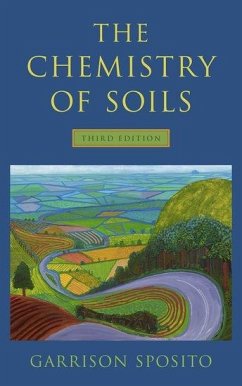
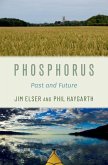
![Successful Farming [microform]: a Ready Reference on All Phases of Agriculture for Farmers of the United States and Canada: Including Soils, Manures . Successful Farming [microform]: a Ready Reference on All Phases of Agriculture for Farmers of the United States and Canada: Including Soils, Manures .](https://bilder.buecher.de/produkte/65/65590/65590631m.jpg)
